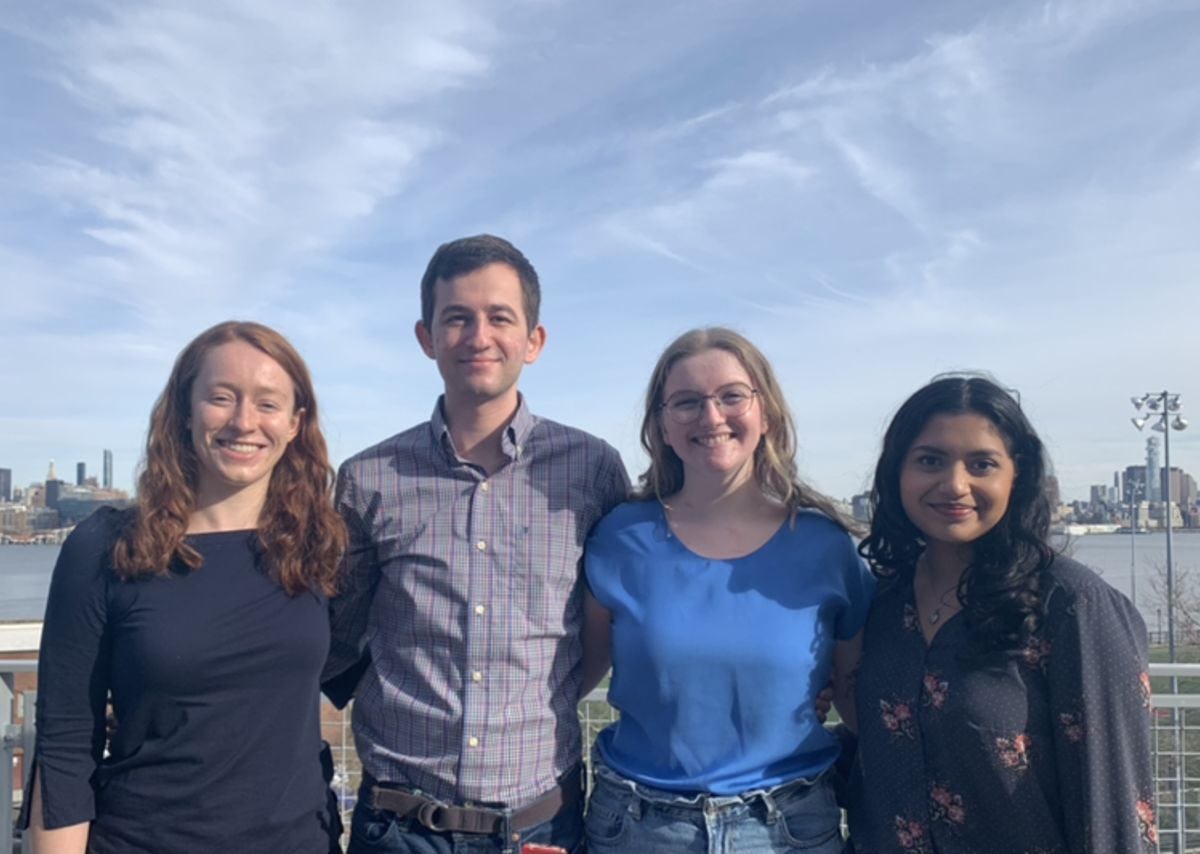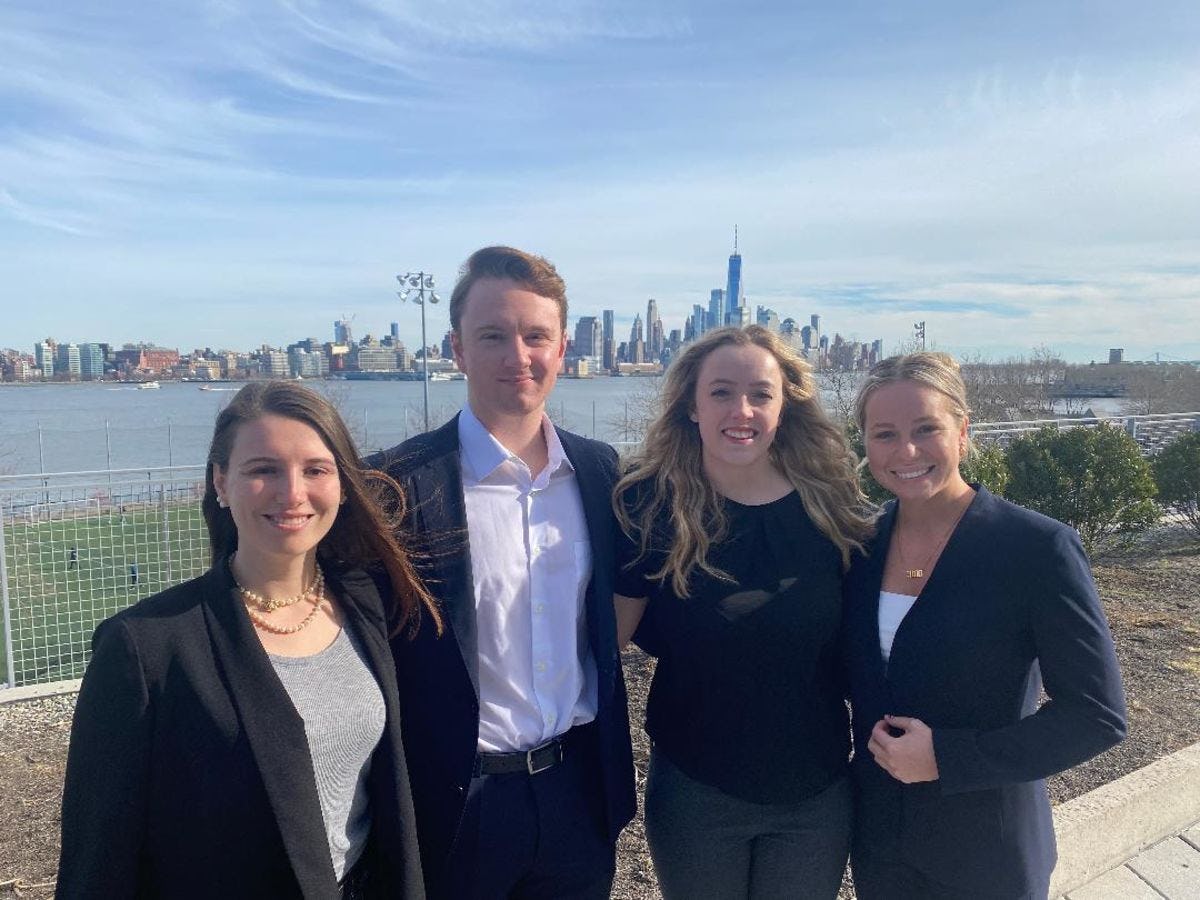Stevens Chemical Engineering Students are Energetic Catalysts of Sustainable Energy
Senior design projects focus on uncovering new ways to make renewable fuels viable for commercial production and use
Traditionally, fuel to run your car and heat your home has come from the dead plants and animals in the form of coal, petroleum and natural gas – fossil fuels that won’t last forever but that continue to increase in both price and potential environmental threats. Energy pioneers are harnessing the power of the sun, wind, hydrogen and other innovative renewable sources, but each has presented challenges in areas such as cost, availability and widespread viability.
But what if the solution could be found in a thriving plant that grows up to three feet a day, or the leftover grease from fried foods eaten worldwide?
As part of their final year at Stevens Institute of Technology, three groups of chemical engineering students tackled senior design projects to investigate how to efficiently create such biodiesel fuels.
“This is a unique design spine in the Stevens undergraduate curriculum,” said the students’ advisor, Yujun Zhao, teaching associate professor and associate chair in the Department of Chemical Engineering and Materials Science. “These students brought entrepreneurial thinking to developing innovative production processes and catalysts to produce biofuels from nonfood biomass and biomass waste, integrating chemical engineering principles and implementing novel technologies for projects with great industrial and social significance. Through their hands-on experience solving real-word problems, I have been proud to see them become more confident and prepared for their future professional careers.”
Read on to meet these enterprising students and their energizing senior design projects.
World’s fastest-growing plant could fast-track world’s sustainable fuel options: Production of bioethanol from bamboo
Biodegradable, renewable, generally carbon-neutral – bioethanol (also known as ethanol) shows strong promise as a sustainable alternative to fossil fuels. Currently, it’s made primarily from corn and sugarcane from North and South America, but those crops are also needed for food supplies.
In contrast, abundant, fast-growing bamboo from Asia can theoretically be converted into 99.7% pure, fuel-grade bioethanol more efficiently, with lower greenhouse gas emissions, and no impact on food production. But no one has implemented this concept commercially – yet.
The four five-year students – and longtime friends – on the “Production of Bioethanol from Bamboo” chemical engineering student team at Stevens decided to demonstrate how it could be done. They used AspenPlus modeling software and Microsoft Excel spreadsheets to conceptually design and optimize a processing plant to convert raw bamboo into fuel-grade ethanol.
“Bamboo is considered a lignocellulosic feedstock, because it contains lignin and sugars called cellulose and hemicellulose,” said Alina Chen ’22, who is going to work at Boeing as a materials process engineer after graduation. “Those sugars can be broken down to simpler sugars, namely glucose and xylan, through a process known as enzymatic hydrolysis. After that, those sugars can be fermented into alcohol with the help of yeast and bacteria – similar to how beer is made. From there, it’s a matter of purifying it to be 99.7% ethanol.”
Through their literature review, they investigated how corn and sugarcane become ethanol; whether bamboo, coconut husk or rice straw might be the ideal biomass; and how reactors, enzymes, industrial materials and more all fit into the design.
“We produced fuel-grade ethanol with a yield of 56.64% for every 1 kg of dry bamboo, which is more efficient than corn and sugarcane processes,” said Ameya Ivaturi ’22, who is entering the Global Operations Leadership Development (GOLD) Program at Johnson & Johnson following graduation. “Our process also creates carbon dioxide as a byproduct of fermentation that is purified and can be sold to beverage companies. It was exciting to use all the knowledge from our previous courses and have them culminate in something special.”
While their breakthrough research was an important technical learning experience, their project also became a vital lesson in collaboration, another key skill for future engineers.
“It's not a coincidence that we’re working together,” said Brynn Froehlich ’22, who, after graduation, is heading to PepsiCo as a supply chain associate. “We met in our second year at Stevens, and we’ve become best friends who struggled and bonded through tough classes together. But naturally, our brains are wired differently! We all bring something different, and we all have different approaches. It’s been interesting to learn how to navigate and rewarding that it has gone so smoothly.”
One area that highlighted their diverse work methods involved challenges with the AspenPlus software. Solving unanticipated errors in the system proved tedious, requiring outside research, trial-and-error, and complex mathematics skills rusty from limited use since they had been introduced earlier in the Stevens curriculum.
“Alina is a tutor, and she would explain the logic for us,” said Zeryn Tamton ’22, who will be working at ExxonMobil as a process engineer after graduation. “Brynn is practical, and if we got too caught up in lofty ideas, she'd bring up a simpler solution. Ameya takes the best notes, and she would remind us of something a professor said and suggest we approach it this way. And Alina and I come out of meetings with complete opposite approaches! Among the four of us, we had to find our balance to solve a problem. But I think the fact that we don't all start on the same page made us challenge each other to bring up better solutions.”
Production of biodiesel from waste cooking oil
Someday, while you enjoy your order of crispy French fries, you might also be contributing to sustainable energy sources, thanks to the foundational work of the Stevens “Production of Biodiesel from Waste Cooking Oil” chemical engineering team.
This team has designed an industrial-scale model of how to react waste cooking oil with an alcohol to form a biodiesel, a biodegradable energy source that’s more sustainable, has a lower carbon footprint and can be more cost-effective than traditional diesel fuel.
“We’re giving second life to something that would normally be thrown out,” said Reilly Degroat ’22, who will be working in Siemens Healthcare’s development program upon graduation. “No one is selling it for a high price – places like restaurants want to get rid of it.”
Because it’s admittedly a poor-quality product that typically has a high fatty acid content, waste cooking oil isn’t high on commercial fuel source lists. But after weeks of literature research, this team was convinced of the oil’s strong potential to be repurposed into a sustainable energy product. Using the AspenPlus software and a lot of creativity, the team has designed a biodiesel production process that transforms waste cooking oil into a viable biodiesel – at a remarkable purity of 99.7% by mass.
Production decisions centered on fundamental chemistry questions such as whether to use a waste clarifying catalyst that was also a liquid, called a homogeneous catalyst, or a solid or gas, known as a heterogeneous catalyst, and whether that catalyst should be an acid or a base.
“Reducing the free fatty acid content can lead to other reactions that could create soap or water, especially if you use a base,” explained Sabiha Rahman ’22, who will be joining Merck Pharmaceuticals as a Quality Assurance Associate Specialist in the Quality Line Oversight rotational program after graduation. “We used a homogenous catalyst, adding dissolved hydrogen sulfate as a liquid to the waste cooking oil. We chose an acid catalyst because it’s more efficient and cheaper than a base, even though it requires more pressure and a higher quantity. But we can do the required transesterification, which converts the waste cooking oil into a clarified purified vegetable oil, and esterification, which reacts with the alcohol to make usable biodiesel reactions, simultaneously.”
With the AspenPlus software, the team didn’t have to ship in any waste cooking oil. Instead, all the processes were simulated to generate real-time results.
“A lot of the first issues we faced involved trying to get our purity to that 99.7% level that we needed to be able to sell it to customers,” said Matthew Danski ’22, who has will be working in environmental health and safety with Koch Industries after graduation. “We didn't know what pressure to run at, what temperature, how the whole process should flow from reactor to the decanter to separate the components... A lot of the answers came from our research. And anytime we had issues, Professor Zhao was there to help guide us.”
“We could email him on a Saturday at 10:30 p.m. and tell him we're having a problem, and he’d get us all on Zoom right away and offer suggestions,” added Degroat. “We learned so much from him.”
In addition to introducing an entirely new process for repurposing waste cooking oil into fuel, the project also introduced these students to new ways of thinking about their chosen profession and solving real-world engineering challenges.
“Through this senior design project, we’ve been able to see a project from start to finish, learn how to do the literature review, build a model from nothing, and report on what we did,” said Kathleen Riegner ’22, a fifth-year student on track to complete her master’s degree in December. “All these things will help us in the future.”
Making things happen efficiently: producing biodiesel using titanium oxide as a catalyst
The chemical engineering students on this team also focused on producing biodiesel fuel from waste cooking oil, but their focus was specifically on the efficient catalyst, which allowed them to create and test not only AspenPlus simulations, but also actual fuel.
Their literature review led them to select titanium oxide, a heterogenous, solid acid catalyst.
“We found titanium oxide to be the most inexpensive and effective catalyst for our project,” said Brianna MacLeod ’22, who will be joining Strides Pharma Inc. as a process engineer after she graduates. “Some catalysts needed much more purification. Some required high temperatures in a furnace that we didn't have access to. But we could produce titanium oxide in our laboratory at Stevens, and use it to make biodiesel.”
Because existing methods of producing biodiesel fuel tend to be patented or at least proprietary, the team did not find much of a roadmap to create the required processes.
“We had a general idea of a process flow,” said Chris Giordano ’22, who is interning at DSM Nutritional Products until he completes his last four classes in December. “But it was a challenge to figure out what specific pieces of equipment to use, what temperatures and pressures we needed to run, and what order the purification process should occur, to end up with a product that met at least the required industrial standard of 96.5% purity, while also trying to minimize costs. However, it was rewarding to figure everything out, and then to have tangible results working in the lab.”
While the pandemic did not prevent the team from completing the lab work in person, it did cause supply chain issues that delayed the arrival of key chemicals and condensed the original semester-long lab experiment schedule into an intense two-week experience.
That, in turn, impacted the actual experiment plans. The scheduled five-hour catalyst drying process at two temperatures became a weekend process at a single lower temperature. The 10-experiment schedule was scaled back to one. But it all worked out.
“It would have been great to have all these chemicals by February, take our time and do this multiple times,” said Alexa Coccio ’22, who is still considering her career options after Stevens. “We had to learn how to manage the changes and get the report and everything else done so that when the chemicals finally arrived, we could focus entirely on that part of the project. We learned to be efficient with the sudden unexpected downtime, and not to stress over the things that were out of our control.”
They also learned not to be surprised when those long-awaited chemical reactions yielded startling results.
“We had no idea how these chemicals were going to react together,” said Brittany Seelman ’22, who will complete her final Stevens course in December while working full-time as a process engineer with The Archer-Daniels-Midland Company.
“The first thing we mixed for the catalyst was a clear liquid, and then it started fogging and smoking and it didn't leave the beaker, so it was denser than air but swirling above the liquid,” Seelman continued. “It looked like a little cyclone. And after we added all the chemicals, it formed this off-white gel substance that looked like the slime that kids play with now. Once it came out of the oven, it was little yellow crystals. It was cool to drop all the chemicals together and get to see the actual product and its consistency in person. It made it feel real. And then when we proved that the titanium oxide we had created could work as a catalyst to produce biodiesel, it was exciting to realize that we had developed an efficient, inexpensive, environmentally friendly and profitable way for oil and biodiesel refineries to manufacture engine fuel.”
The titanium oxide catalyst team members were excited to prove in real life that their experiment worked. Adding the catalyst they made to a mix of methanol and vegetable cooking oil resulted in two clear layers – biodiesel on top, and a mix of unreacted cooking oil and methanol on the bottom – plus the remaining catalyst in lumps at the bottom. It’s proof positive that titanium oxide is a viable catalyst for the efficient, economically viable and environmentally friendly production of biodiesel.
Learn more about the Department of Chemical Engineering and Materials Science at Stevens:





